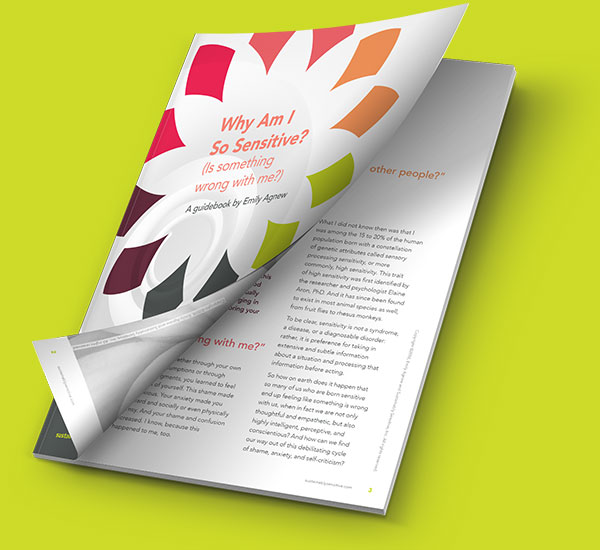Learning how to manage your HSP creativity is a lifetime project, because your life itself is an ongoing act of creation.
If you are a new reader of this newsletter, this might be the first time you’ve heard me wax poetic about dahlias. It won’t be the last, though. I adore dahlias. We have a garden full of them. I even chose a stylized dahlia for my logo, because dahlias are such a useful metaphor for highly sensitive people.
Creativity is a central thread in all my dahlia-themed ponderings, and no wonder. Just as a well-cared-for dahlia plant will bloom wildly for months, HSPs can be profusely creative when we get the right care. Our creativity requires skillful handling, though, because it arises from the very HSP characteristics that also cause overwhelm and overarousal.
HSP creativity is a double-edged sword
As Dr. Elaine Aron puts it in Psychotherapy and the Highly Sensitive Person, “It is safe to say that every sensitive person is unusually creative, even if it is going unexpressed or there is no particular, exceptional talent present.” (paperback edition p. 104.) She also explains why sensitive people are creative:
In [highly sensitive] humans, the more sensitive strategy of scanning the environment and attending to details of stimulation has been observed in functional magnetic resonance imaging (fMRI; Jagiellowicz, Xu, et al., in press) and more generally in thinking and feeling before and during a behavior. This strategy allows for greater awareness of subtleties and consequences. This in turn leads, for example, to high levels of conscientiousness and creativity. (paperback edition, p. 3)
Our keen awareness of subtleties and consequences feeds our creativity, but it also creates problems. Dr. Aron explains that “on the negative side, this elaborate processing creates a greater potential for being overstimulated and troubled by stressful life events.”
In other words, HSPs possess powerful gifts: our sensitivity to subtlety, our keen attunement to both immediate and longer-term consequences, and our conscientiousness. However, we need to manage these gifts well, or risk being chronically overwhelmed.
How do we manage our creative gifts?
Managing overarousal is arguably the central challenge for HSPs, and I’ve written a variety of dahlia-themed articles directly addressing the sensitive challenges Dr. Aron describes above, including HSP self-care, overstimulation, depth of processing, and resilience.
This time, though, I’m inspired to write about the creative process itself. It is late summer here. Our dahlias have grown taller than me and are heavy with blooms. My principal job now—aside from filling our vases with cut flowers —is to make sure the plants don’t collapse under the sheer weight of their own creative outpouring.
I do that by checking each plant every few days and patiently tying up any stems in danger of breaking. As I did that last week, a deep thought floated into my mind: “You can’t tie something up unless you have something to tie it to.”
Having absorbed this rather obvious truth, I went on to reflect upon the importance of stakes. I realized that while our dahlia stakes look unassuming, they can teach me important lessons about managing sensitive creativity, like—
1—Set boundaries and keep them
A stake, I realized, represents a commitment. There’s nothing wishy-washy about a stake. With our dahlia stakes, we choose a spot a mere inch from the tuber, then we use a cartoonishly large, heavy rubber mallet to pound the stake deep into the ground.
You need boundaries like that for your creative energy, too. HSPs have trouble with transitions, and when you are absorbed in creating, it’s easy to miss meals, stay up late, use up time needed for more boring things like paying bills….and end up overwhelmed.
For that reason, humble, boring “stakes” like regular breaks, consistent sleep, and predictable meals provide the sturdy, flexible personal infrastructure we need to put in place so our creativity can flow freely without burning us out.
I’ll never forget the first time we came out to the garden and found an entire five-foot-tall dahlia bush toppled on the ground, its main stem severed beyond rescue. The wooden stake supporting it had rotted, then broken under the sheer weight of all that biomass.
The next year, we invested in steel stakes. Similarly, your personal infrastructure will always be a work in progress. Your strategies work…until they don’t. Then you know what parts of your infrastructure need to be stronger.
2—Anticipate and plan ahead
There’s no way around it: a five-foot-tall stake looks ridiculous next to a four-inch-tall baby dahlia plant. It’s hard to believe that the plant will outgrow the stake a few weeks down the road, and in the meantime, our garden looks like it is infested with giant toothpicks. Nonetheless, the stakes need to be there from the start.
Creative projects are like that. You may need to set up support structures that initially look like overkill. Here’s where your HSP foresight, your imagination, and your spiritual intuition can shine. You can use them to make sure you have the right-sized stakes in the right place.
In fact, I’ve learned never to ignore the inspiration to clean up, to organize, or to create templates, systems, or routines. These urges are the first sign that a big project is coming, and I’ve learned to trust them, even if I have no idea what the project is yet. In the meantime, my job is to get ready and prepare the necessary infrastructure.
3—Be discerning about what you take on.
The creative part of me wants to do everything. It hates to hear about limits. But if I overcommit myself, even the most effective creativity management structures will not protect me from creative overwhelm.
In short, HSPs have to be discerning about what we take on…and that discernment comes from your spiritual intuition in all its forms. It may show up like the Monty Python God who dispenses loud commands from the clouds. More likely, you will hear that “still, small, voice.” And never underestimate that most ordinary form of spiritual guidance, common sense.
In that regard, you could say your spiritual intuition is your “meta-stake”—the stake that supports all the other stakes. When you stay connected to your spiritual intuition, you get the clarity you need to decide what projects you will take on. And as we’ve discussed above, you’ll also be inspired to create whatever supports and structures those projects will require.
The yin and yang of a strong creative support system
A single dahlia stake can support a startling weight of biomass, because of the stabilizing tension of opposing forces. Some branches pull to the right. Others pull to the left, the front, or the back.
To manage the potentially overwhelming profusion of your HSP creativity, you’ll need to balance a different kind of opposing energies: the yin of inner empathy, and the yang of action and boundaries. When they are balanced, these two energies stabilize each other in an infinite loop.
To invoke your yin energy, you engage in an inner dialogue process. You empathize with your parts. As you learn how to be present with anything and everything that is going on in you, your inner knowing naturally begins to flow more freely.
Next, acting on your sense of inner rightness, you invoke yang energy by taking action. Finally, you go inwards again, sensing what has changed as a result of the action.
As you engage in this yin-yang cycle—listening, acting, and observing—you facilitate the forward movement of your creative process. I do the same with each of our dahlia plants. I watch, and when I see that a plant needs additional support, I tie it to its stake. Thus, I am both responsive and directive: I respond to the plant’s growth, and with my stakes and ties, I influence the direction of that growth.
Staking your actions to your values
In life, the direction of our growth depends on the way we prioritize our values. When I’m intentional about what I value—that is, when I’m choiceful about what I plant in my personal garden—I experience the kind of deeper happiness that flows from trusting my spiritual intuition.
Your life itself is your most important creation. We can facilitate this biggest of all projects by rooting ourselves in the ground of being, nurturing and strengthening our connection to our spiritual intuition, and acting on the guidance we receive.
Photo ©2021 Emily Agnew




















Thank you so much Emily, I really needed to read this today. I’ve been going through a shame attack for a few days and know that I need to review my support. I can’t go back to the place that I operated and survived from for many years. I’ve been much more thriving than surviving. This has made me think and given me hope.
I marvel with each blog I read. Every sentence, every paragraph is full of knowledge , clarification, and validation for me personally as a fairly newly discovered HSP. I like the way you have compared your dahlias to us as HSP’s. I don’t know if visual learning is an HSP trait , or an individual trait, but concepts are sometimes easier for me to understand with visual help. For the past year I have been trying to nurture my creativity. I have been hesitant because as I have realized I am a Renaissance Person in work, I must be a Renaissance Person in creativity as well. I’m either so overwhelmed with wanting to accomplish something creative, that I don’t know where to start, or I start something…such as watercolour painting….the creativity for this lasts maybe a couple of months and I’ve spent money on watercolour paints, and then I stop and have no interest to return to the respective creative outlet. What is going on here? What is the reason for this? If you know Emily, or if any of your readers know, please fill me in! Thank you
Suzanne, you would likely need to do some inner work to find out what happens with this creativity cycle you are seeing. It may be that you lose interest because after the “honeymoon” period, an inner critic or perfectionist part of you takes over? But we don’t know yet.
Hmm. I will need to reread this article and see if I can apply section by section to my life. Inner critic….from the voice of someone who has stated I was useless? Perfectionist…trying to figure out where this originates from.,,,possibly because this was the only way I received attention that I needed as a child…from my teacher’s when I would get high marks? I don’t have the energy for inner work with someone in all the context that it may involve…..visual, auditory, emotional stimulation. But writing is a strength of mine, and I can’t hear a person’s tone of voice necessarily or watch their body language, so articles and blogs to help with inner work for now, is what it will be I guess. Thank you for your articles and kind responses! Very much appreciated.
You are welcome S, and that’s great that writing helps you clarify what is going on in you.